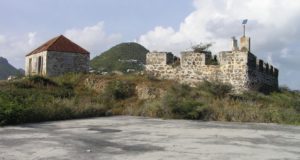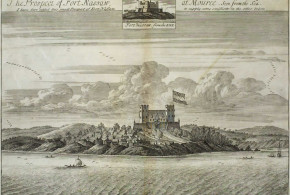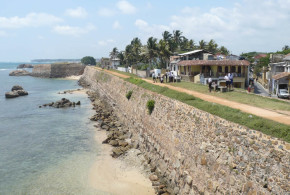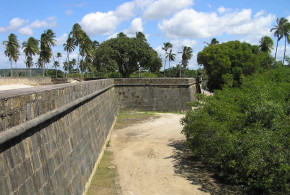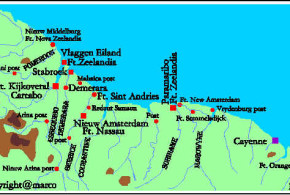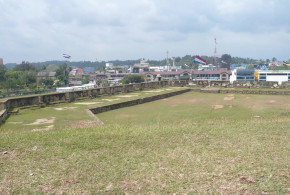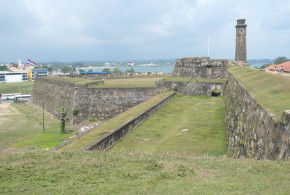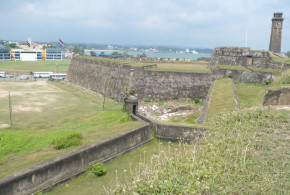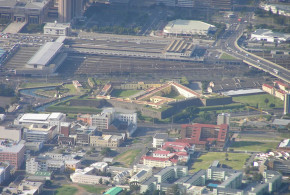Written by Marco Ramerini. English text revision by Dietrich Köster.
DUTCH EMPIRE: AFRICA
MAURITANIA:
– Monod,Th., “L’île d’Arguin (Mauritanie), essai historique” 327 pp., 5 maps, IICT and CECA 1983, Lisbon, Portugal. Detailed research on Arguin castle history during the Portuguese, Dutch and Brandenburg periods.
WEST AFRICA, GHANA (GOLD COAST):
– Various Authors, “John Conny & Goombay Drum ignite the imagination of the African Diaspora”, pp. 84-88, in: Angwandah, J. Kwesi, “Castles and forts of Ghana”, Ghana Museums and Monuments Board, Atlante, 1999, Paris, France.
– Anqwandah, J. Kwesi “Castles and forts of Ghana”, Ghana Museums and Monuments Board, Atlante, 1999, Paris, France.
– Clement, Jan J., “De West-Indische Compagnie op de Goudkust in West-Afrika” Vol. 1: “Butler’s Bittere Jaren (omstreeks 1721)”, 356 pp. 1999, Rotterdam, The Netherlands. This volume contains the correspondence between Willem Butler during his directorship at Elmina from 1718 to 1722 and the directors of the WIC.
– Clement, Jan J., “De West-Indische Compagnie op de Goudkust in West-Afrika” Vol. 2: “Dagregister Elmina 1721”, 320 pp., 1999, Rotterdam, The Netherlands. This volume contains the complete Journal or day-book (Dagregister) of Elmina of the 1721.
– Clement, Jan J., “De West-Indische Compagnie op de Goudkust in West-Afrika” Vol. 3: “Acht bevelhebbers op de Goudkust”, 386 pp., 1999, Rotterdam, The Netherlands. This volume contains selected pieces of correspondence from several directors-general during the period 1700-1726.
– Daaku, Kwame Yeboa “Trade and politics on the Gold Coast 1600-1720, a study of the African reaction to European trade”, xviii, 219 pp., Clarendon, 1970, London, United Kingdom.
– Decorse, Christopher, “An Archaeology of Elmina : Africans and Europeans on the Gold Coast, 1400-1900”, 2001, Smithsonian Institution Press, 2001.
– Doortmont, Michel, “Consular and diplomatic ties between Ghana and the Netherlands: a longstanding relationship”, Internet article, 1999
– Doortmont, Michel and van den Nieuwenhof, Michel, “Ancient forts and castles in Ghana”, Internet article, 1999. The history of Fort Patience at Apam and Usher Fort in Accra.
– Ephson, I. S., “Ancient forts and castles of the Gold Coast (Ghana)”, 112 pp. 18 illustrations, Ilen Publications, 1970, Accra, Ghana. Index: The origins; location of the forts and castles; number of forts and castles; the tenants; unhappy incident; gallant governors; problems of the forts and castles; no more forts and castles; cui bono; the surviving settlements. – Feinberg, Harvey M., “Africans and Europeans in West Africa : Elminans and Dutchmen on the Gold Coast during the eighteenth century”, xvi, 186 pp., illustrations, Transactions of the American philosophical society, v. 79, pt. 7 (1989), The American Philosophical Society, 1989, Philadelphia, USA. Index: The Akan on the Gold Coast; Europeans on the Gold Coast: the Portuguese 1471-1642; The Dutch in West Africa from 1593; Akan participation in the Atlantic trading system; an introdution to Elmina; the Elmina political framework; the functioning of Government: justice and dispute settlement, foreign affairs; Elmina-Dutch relations; conclusion: Elmina as an enclave entrepot; Elmina chronology; weights, measures and definitions; directors general and presidents of the second West India Company; counts of indictment and defense of the Negroes of Mina; pen and contract; Elmina leaders; bibliography.
– Feinberg, Harvey M., “New data on European mortality in West Africa: the Dutch on the Gold Coast 1719-1760”, in: “An Expanding World”, Vol. n° 4. Disney, A. “Historiography of Europeans in Africa and Asia 1450-1800”, Ashgate, Variorum, vol. n° 4, 1995; pp. 69-83 Also in: “Journal of African History” vol. 15, n° 3, pp. 357-371, 1974, Cambridge.
– Herman, H., “Onze bezittingen op de kust van Guinea en de krijgsverrichtingen aldaar, 1592-1872”, 271 pp., 2000, Rotterdam, The Netherlands
– Jones, Adam (editors), “West Africa in the mid-seventeenth century: an anonymous Dutch manuscript”, 348 pp., includes 3 maps, 2 tables, and 5 photo illustrations. Original Dutch and annotated English translation of unpublished records on the West African coast. Based on activities of the Dutch West India Company of circa 1624-55, papers include navigational, commercial, ethnographic, linguistic and other materials of practical utility to sevententh century traders.
– Kea, Ray A., “Settlements, trade and politics in the seventeenth-century Gold Coast”, xvii, 475 pp., Studies in Atlantic history and culture, Johns Hopkins University Press, 1982, Baltimore. A study concerning the African Kingdoms on the Gold Coast; there is little about the European forts.
– Law , R., “Trade and politics behind the Slave Coast: the lagoon traffic and the rise of Lagos, 1500-1800”, in: “An Expanding World”, Vol. n° 27. Forster, R., “European and non-European societies, 1450-1800” Vol. 1 “The long duree, eurocentrism, encounters on the periphery of Africa and Asia”, Ashgate, Variorum, vol. n° 27; pp. 275-302. Also in: “Journal of African History” vol. XXIV, 1983, pp. 321-348.
– Lawrence, A. W., “Trade Castles and Forts of West Africa”, 390 pp., 48 maps & 158 plates, Jonathan Cape, 1963, London, United Kingdom. A detailed description of about 40 Europeans forts and castles from Arguin (Mauritania) to Whydah or Ouidah (Benin). Many illustrations and maps of the forts. Chronological history of the forts. Index: The place of the fortsystem in history; the setting of times; organization and personnel; life at the forts; relations between fort and town; types of buildings; materials and structure; early draughtsmen; Elmina castle: the Portuguese and later Dutch headquarters; other headquarters: Cape Coast Castle, Christiansborg, Princestown; early forts: Axim, Mouri, Cormantin, Gambia, Butre, Shama; forts about 1700: Akwida, Commenda, Dixcove, Apam, Sekondi, Beraku; forts of the late eighteenth century: Anomabu, Beyin, Keta.
– Ratelband, K. (editor), “Vijf dagregisters van het kasteel Sao Jorge da Mina (Elmina) aan de Goudkust (1645-1647)”, cx+439 pp., 7 plates, 7 facsimiles, 4 maps, Linschoten Vereeniging, 55, Martinus Nijhoff, 1953, ‘s-Gravenhage, The Netherlands.
– van Dantzig, A. “Les Hollandais sur la côte de Guinée, a l’époque de l’essor de l’Ashanti et du Dahomey 1680-1740”, 327 pp., 4 maps, Société Française d’Histoire d’Outre-Mer, 1980, Paris, France. Index: La compagnie néerlandaise des Indes Occidentales sur la côte de Guinée, la traite de l’or, la traite des esclaves et l’intervention européenne dans la politique africaine, les changements des années 1700: l’or ou l’ esclave?, l’adaptation aux nouvelles conditions, l’ Akwamu, le Dahomey et les Hollandais 1710 – 1740, le déclin de l’ Akwamu et ses conséquences.
– van Dantzig, A. “Forts and castles of Ghana”, 96 pp., Sedco Publishing Limited, 1980, Accra, Ghana.
– van Dantzig, A. and Priddy, B., “A short history of the forts and castles of Ghana”, 59 pp., map and illustrations, Liberty Press, 1971, Accra, Ghana. Index: The Portuguese period, Dutch penetration and the expulsion of the Portuguese, English, Swedish and Danish penetration, growth of the English trade, the Brandenburg Company, the 18th century, the 19th century.
– van den Broecke, Pieter, “Reizen naar West-Afrika 1605-1614”, 124 pp., 5 maps and 6 plates, Linschoten Vereeniging LII, Uitgegeven door K. Ratelband, ‘s-Gravenhage, 1950, Describes a period when the WIC was still non-existent, the Dutch captured forts on the Guinea coast even before this Company was erected.
– van Kessel, Ineke, “The black Dutchmen: African soldiers in the Netherlands East Indies”, Internet article, 2000.
– Yarak, Larry W., “Asante and the Dutch 1744-1873”, 332 pp. 7 maps, 1 figure, 7 tables, Clarendon Press, 1990, Oxford, United Kingdom. Index: 1. An Asante residency in Elmina: the career of Debosohene Kwadwo Akyampon 1822-1832; 2. Asante and the Dutch: an overview 1700-1872; 3. The Asantehene’s Kostgeld: tribute, rent, and political myth 1744-1872; 4. The development of Asante administration of Dutch and Elmina affairs, I: Tribute collectors, traders, and diplomats 1744-1816; 5. The development of Asante administration of Dutch and Elmina affairs, II: Coastal residents and court officials 1817-1873; 6. Office, expertise, and personality: an ‘internal’ perspective on the administration of Dutch and Elmina affairs in Asante; Conclusion; Bibliography; Glossary; Index
– Yarak, Larry W., “The Dutch in Nineteenth-Century West Africa: A Report on Research into the Character of the Dutch Imperialism”, Lecture at the Centre for the History of European Expansion, University of Leiden, The Netherlands, May 31, 1990.
– Yarak, Larry W., “Dutch Military Recruitment on the Gold Coast and in Ashanti, 1831-72”. Symposium on Source Material for Studying the Slave Trade and the African Diaspora, University of Stirling, Stirling, Scotland, April 13, 1996.
– Yarak, Larry W. “Early Photography in Elmina”, in: Ghana Studies Council Newsletter, No. 8 (1995).
ATLANTIC OCEAN, ANGOLA:
– Beintema, Albert J., “Early shipping in Tristan da Cunha waters”, Internet article.
– Boxer, Ch. R., “Salvador de Sá and the struggle for Brazil and Angola 1602-1686”, 444 pp., maps, Athlone Press, 1952 London, United Kingdom The history of the life of Salvador Correia de Sá, the establishment of Portuguese control over Brazil and the war with the Dutch in Brazil and Angola. Index: Spanish marriage, the expedition of the vassals, the road to Potosì, governor of Rio de Janeiro 1637-1643, general of the Brazil fleets, Angola, the black mother, captain-general of the South, “a notable old stickler”.
– Emmer, P. C. “The Dutch in the Atlantic economy, 1580-1880. Trade, slavery and emancipation” 304 pp., 3 maps, Variorum, Ashgate, 1998, London, United Kingdom. Contents: Preface; Acknowledgements; List of maps and tables; The Dutch in the Atlantic Economy, 1580-1880: an introduction; The Dutch and the making of the Second Atlantic System; The Dutch participation in the Atlantic slave trade, 1596-1650, by Ernst van den Boogaart; The West India Company, 1621-1791: Dutch or Atlantic?; “Jesus Christ was good but trade was better”: an overview of the transit trade of the Dutch Antilles, 1634-1795; Abolition of the abolished: the illegal Dutch slave trade and the mixed courts; Anti-slavery and the Dutch: abolition without reform; Changes in the Suriname labour market during the 19th century: Smith and Marx in the West Indies; Plantation slavery in Suriname in the last decade before emancipation: the case of Catharina Sophia, by Ernst van den Boogaart; The price of freedom: the constraints of change in post-emancipation America; Between slavery and freedom: the period of apprenticeship in Suriname (Dutch Guiana), 1863-73; The ideology of free labour and Dutch colonial policy, 1830-70; Select Bibliography; Index.
– Emmer, P. C. & Klooster, W. W., “The Dutch Atlantic, 1600-1800: expansion without Empire”, in: “Itinerario”, vol. XXIII, 2/1999, pp. 48-69
– Esteves, Maria Luísa, “Os Holandeses em Angola. Decadência do comércio externo e soluções locais adoptadas”, in: STUDIA N° 52, 1994, Lisbon, Portugal.
– Mathias, Lt, “St. Helena under the Dutch East India Company”, 1928
– Postma, J.M., “The Dutch in the Atlantic slave trade 1600-1815”, 428 pp., 9 maps, Cambridge University Press 1990 Cambridge, Massachusetts, USA. Index: Foundations of the slave traffic 1600-1661, Curaçao and the Asiento trade 1650-1730, the Dutch on the West Africa coast, trade and politics on the African coast, volume of African exports and origins of slaves, organization and mechanics of trade, the triangular trade, the Dutch plantation colonies under WIC monopoly 1618-1738, the era of the free trade 1730-1780, the slaves: their treatment and mortality, finances, marketing and profitability, the end of the Dutch slave trade 1781-1815.
– Ratelband, K. “De expeditie van Jol naar Angola en São Tomé 30 Mei 1641 -31 October 1641”, De West-Indische Gids XXIV, 1943.
– Silva Rego, A. da, “A dupla restauração de Angola 1641-1648”, IX, 274pp., 1948, Lisbon, Portugal.
SOUTH AFRICA:
Abrahams-Wills, G. & Fourshé, K., “Burial from the Seventeenth Century Dutch Fort de Goede Hoop at the Cape”, in: “South African Field Archaeology”, n° 4, 1995, pp. 95-102.
– Armstrong, James C., “The Ceylon connection: convicts and exiles from Ceylon sent to the Cape of Good Hope during the Dutch East India Company period”, Australian Humanities Review. Abstract of a paper presented at the Interdisciplinary conference “Colonial places, convict spaces: penal transportation in global context, ca. 1600-1940”, 9-10 December 1999, Department of Economic & Social History, University of Leicester (United Kingdom).
– Bank, A. and Minkley, G., “Editorial, Genealogies of Space and Identity in Cape Town”, in: Journal of Cape History “Kronos”, Tydskrif vir Kaaplandse Geskiedenis, n° 25, 1998/1999.
– Bozard, Donald Curtis, “Burgher, Boer and Bondsman: a survey of slavery at the Cape of Good Hope under the Dutch East India Company, 1652-1795”, 652 pp., PhD. Thesis, University of Maryland College Park, 1987.
– Elphick, R., and Hermann Giliomee “The Shaping of South African Society, 1652-1820”, 1979, Cape Town and London.
– Fransen, Hans & Cook, Mary Alexander, “The Old Buildings of the Cape”, AA Balkema 1980, Cape Town.
– Gerstner, J. Neil, “The thousand generation covenant: Dutch Reformed covenant theology and group identity in colonial South Africa, 1652-1814”, XI, 280 pp., E. J. Brill, 1991, Leiden, The Netherlasnds. A historical study of the role of theological concepts in the development of Afrikaner group identity during the period when South Africa was a Dutch colony.
– Guelke, Leonard, ” Frontier settlement in early Dutch South Africa”, pp. 25-42 Annals of the Association of American Geographers, vol. 66, nº1, March 1976.
– Guelke, Leonard, “Freehold farmers and frontier settlers, 1675-1780”, in: “An Expanding World”, Vol. n° 4.
– Disney, A., “Historiography of Europeans in Africa and Asia 1450-1800”, Ashgate, Variorum, vol. n° 4, 1995, pp. 174-216. Also in: “The shaping of South African Society 1652-1840”, pp. 66-108, 1986, Middelton, Connecticut, USA.
– Guelke, Leonard “The anatomy of a colonial settler population: Cape Colony, 1657-1750”, in: “An Expanding World”, Vol. n° 29.
– Nizza da Silva, M. B., “Historiography of Europeans in Africa and Asia 1500-1800”, Ashgate, Variorum, vol. n° 29, 1998; pp. 293-313. Also in: “International Journal of African Historical Studies”, pp. 453-473, Vol. 21, n° 3, 1988, Boston, Massachusetts, USA.
– Marais, Johannes Stephanus, “The Cape Coloured People, 1652-1937”, 296 pp., Longmans 1939, London (reprint Witwatersrand University Press: 1957, 1968, 1978).
– Mc Carter, J. “The Dutch Reformed Church in South Africa. With Notices of the other Denominations. A Historical Sketch”, 152 pp., with 2 lithograph plates, W & C Inglis, 1869. A historical sketch of the development of the church under VOC and British rule, its schisms and dissidents, as well as short data on other churches in the territory.
– Ploeger, J., “Regiment de Meuron”, in: Military History Journal, Vol. 1, n° 4, June 1969, The South African Military History Society, Die Suid-Afrikaanse Krygshistoriese Vereniging, South Africa.
– Raven-Hart, Major R. “Before van Riebeeck – Callers at South Africa from 1488 to 1652”, viii+216 pp., 18 plates with 26 black-and-white illustrations, C. Struik (Pty.) Ltd., 1967,Cape Town. An account of travellers stopping at the Cape, drawing on much previously unpublished material found in log books and diaries from the Archives of Cape Town and The Hague etc., 153 entries: from Bartholomeu Dias in 1488 to Jean-Baptiste Tavernier in 1649.
– Raven-Hart, R., “Cape of Good Hope 1652-1702. The first fifty years of Dutch colonisation as seen by callers”, 2 vols. Vol. I: xvi+222 pp. with 28 black-and-white illustrations. Vol. II: xii+303 pp., with 37 black-and-white illustrations . A. A. Balkema, 1971, Cape Town, South Africa. 103 accounts by visitors to the Cape between 1652 and 1702, taken from the original Dutch, English, French, Portuguese, Danish and German. The Foundations 1652-1662. Too many Cooks 1663-1679. Expansion and Exploration 1680-1698. Greed and Graft 1699-1702.
– Ross, Robert, “The first two centuries of colonial agriculture in the Cape Colony: a historiographical Review”, in: “An expanding world”, vol. n° 25, “Settlement patterns in early modern colonization, 16th-18th century”, pp. 301-320, Ashgate Variorum, 1998, in: Social Dynamics, IX, n° 1, pp. 30-49, Centre of African Studies, University of Cape Town, 1983, Rondebosch, South Africa.
– Schrire, C. & Deacon, J., “The Indigenous Artefacts from Oudepost I, a Colonial Outpost of the VOC at Saldanha Bay, Cape”, in: “South African Archaeological Bulletin”, n° 44, 1989, pp. 105-113.
– Schutte, Gerrit, “Between Amsterdam and Batavia: Cape society and the Calvinist church under the Dutch East India Company”, in: “Kronos, Journal of Cape History”, n° 25, 1998/1999.
– Sleigh, D., “The Forts of the Liesbeeck Frontier”, Castle Military Museum, Cape Town, South Africa. The Dutch East India Company’s trade with the East as well as its trade route are examined, the importance of the geographical position and strategic role of Table Bay are shown, and the problems that beset the Company’s new maritime replenishment station that was established in 1652 are explained. The effects of a European commercial settlement on the local aboriginal herdsman, the privations of the settlers and their contest with the Khoina for the resources of the fertile Liesbeeck Valley, are all dealt with in detail. A number of manned forts were built along the Liesbeeck River at this time, which became the first of many Eastern Frontiers in this country’s history and the one that had the most lasting effect. [The South African Military History Society]
– Smith, Andrew B., “The French Period at the Cape, 1781-1783: a report on Excavations at Conway Redoubt”, in: Military History Journal, Vol. 5, n° 3, June 1981, The South African Military History Society, Die Suid-Afrikaanse Krygshistoriese Vereniging, South Africa.
– Theal, G., “The history of South Africa under the administration of the Dutch East India Company (1652 – 1795)”, 459 + 462 pp., maps, 2 vols., Swan Sonnenschein & Co., 1897, London, United Kingdom.
– Trotter, A. F., “Old Cape Colony: a Chronicle of her Men and Houses from 1652 to 1806”, 320 pp., illustrations throughout, County Library series No.II, Selwyn & Blount, 1903.
– van Rensburg, A. M., “My genetic enrichment: slaves at the Cape, South Africa”, Internet article.
– van Rensburg, A. M., “Let them speak: Slave Stamouers of South Africa”, Internet article.
– Villiers, J. de, “The Pandour Corps at the Cape during the rule of the Dutch East India Company”, in: Military History Journal, Vol. 3, n° 3, June 1975, The South African Military History Society, Die Suid-Afrikaanse Krygshistoriese Vereniging, South Africa.
– Welch, Sidney R., “Portuguese and Dutch in South Africa 1641-1806”, 944 pp., Juta & Co. Ltd, 1951, Cape Town, South Africa.
– Worden, N., van Heyningen, E. and Bickford-Smith, V., “Cape town: the making of a city. An illustrated social history (under Dutch and British rule)”, 283 pp., with many illustrations, 1998, Hilversum. Beginning in the 17th century with the tiny Dutch settlement, the book charts the growth of Cape Town over almost three centuries, ending with the British colonial city.
– Worden, Nigel, “Space and identity in VOC Cape Town”, in: “Kronos, Journal of Cape History” n° 25, 1998/1999. – Zollner, Linda, “Germans in South Africa”, Internet article.
BASTERS:
– Various Authors, “The Rehoboth Community of South West Africa”, in: “African Studies”, n° 14, 1955, pp. 175-200
– Bayer, Maximilian, “The Rehoboth Nation of Namibia”, 1906 (1984).
– Britz, Rudolf G., Lang, Hartmut and Limpricht, Cornelia, “A Concise History of the Rehoboth Basters until 1990”, Klaus Hess Publishers, Windhoek, Namibia
– Lang, Hartmut “The Population Development of the Rehoboth Basters”, in: “Anthropos” 93: pp. 381-391
– Orizio, Riccardo, “Tribù bianche perdute: viaggio tra i dimenticati”, xv+281 pp., Editori Laterza, 2000, Bari, Italy. English edition: “Lost White tribes: Journeys among the Forgotten”, 281 pp., Secker & Warburg, 2000 Indice: Sri Lanka: quattro secoli di nostalgia olandese; Giamaica: gli schiavi tedeschi di Seaford Town; Brasile: via con il vento degli ultimi sudisti; Haiti: i polacchi di Papà Doc; Namibia: la Terra Promessa dei Basters; Guadalupa: i duchi della canna da zucchero. The author investigates: the Dutch Burghers of Sri Lanka; the Germans of Seaford Town (Jamaica); the Confederados of Brazil; the Poles of Haiti; the Basters of Namibia; the Blancs Matignon of Guadeloupe.
– Pearson, Patrick, “The History and social structure of the Rehoboth Baster Community of Namibia”, 541 pp., unpublished MA Thesis, University of Witwatersrand, 1986, Johannesburg, South Africa.
– Spelbos, Peter, “The Genesis of the Rehoboth Basters as a People, 1863-1928”, 151 pp., Leiden, 1994.
– Viall, D., “The History of the Rehoboth Basters”, 66 pp., unpublished report to the Prime Minister of South Africa, Rehoboth, 27 January 1959.
MADAGASCAR, MAURITIUS:
– Various Authors, “Fort Frederik Hendrik on Mauritius”, Internet article, 2000
– Bonaparte, R., “Le premier établissement des Hollandais à Maurice” 1899, Paris, France
– Moree, P.J., “A coincise history of Dutch Mauritius 1598-1711: a fruitful and healthy land”, 127 pp., 27 illustrations and maps, Kegan Paul International & IIAS, 1998, London, United Kingdom. Very interesting; it is one of the few books on this subject. The years 1598-1638, the first period of occupation 1638-1658, the years 1658-1664, the second period of occupation 1664-1710.
– Ranjeva-Rabetafika, Yvette; Baesjou, René and Everts Natalie, “Of paper and men: a note on the archives of the VOC as a source for the history of Madagascar”, in: “Itinerario”, vol. XXIV, 2000/1, pp. 45-67.
 Colonial Voyage The website dedicated to the Colonial History
Colonial Voyage The website dedicated to the Colonial History





